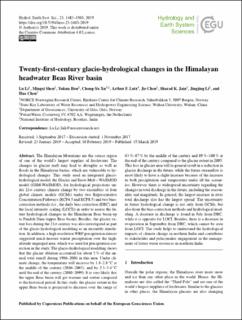| dc.contributor.author | Li, Lu | |
| dc.contributor.author | Shen, Mingxi | |
| dc.contributor.author | Hou, Yukun | |
| dc.contributor.author | Xu, Chong-Yu | |
| dc.contributor.author | Lutz, Arthur | |
| dc.contributor.author | Chen, Jie | |
| dc.contributor.author | Jain, Sharad K. | |
| dc.contributor.author | Li, Jingjing | |
| dc.contributor.author | Chen, Hua | |
| dc.date.accessioned | 2020-03-25T15:12:10Z | |
| dc.date.available | 2020-03-25T15:12:10Z | |
| dc.date.created | 2019-03-27T15:08:14Z | |
| dc.date.issued | 2019 | |
| dc.identifier.citation | Hydrology and Earth System Sciences. 2019, 23 (3), 1483-1503. | |
| dc.identifier.issn | 1027-5606 | |
| dc.identifier.uri | https://hdl.handle.net/11250/2648674 | |
| dc.description.abstract | The Himalayan Mountains are the source region of one of the world's largest supplies of freshwater. The changes in glacier melt may lead to droughts as well as floods in the Himalayan basins, which are vulnerable to hydrological changes. This study used an integrated glacio-hydrological model, the Glacier and Snow Melt – WASMOD model (GSM-WASMOD), for hydrological projections under 21st century climate change by two ensembles of four global climate models (GCMs) under two Representative Concentration Pathways (RCP4.5 and RCP8.5) and two bias-correction methods (i.e., the daily bias correction (DBC) and the local intensity scaling (LOCI)) in order to assess the future hydrological changes in the Himalayan Beas basin up to Pandoh Dam (upper Beas basin). Besides, the glacier extent loss during the 21st century was also investigated as part of the glacio-hydrological modeling as an ensemble simulation. In addition, a high-resolution WRF precipitation dataset suggested much heavier winter precipitation over the high-altitude ungauged area, which was used for precipitation correction in the study. The glacio-hydrological modeling shows that the glacier ablation accounted for about 5 % of the annual total runoff during 1986–2004 in this area. Under climate change, the temperature will increase by 1.8–2.8 ∘C at the middle of the century (2046–2065), and by 2.3–5.4 ∘C until the end of the century (2080–2099). It is very likely that the upper Beas basin will get warmer and wetter compared to the historical period. In this study, the glacier extent in the upper Beas basin is projected to decrease over the range of 63 %–87 % by the middle of the century and 89 %–100 % at the end of the century compared to the glacier extent in 2005. This loss in glacier area will in general result in a reduction in glacier discharge in the future, while the future streamflow is most likely to have a slight increase because of the increase in both precipitation and temperature under all the scenarios. However, there is widespread uncertainty regarding the changes in total discharge in the future, including the seasonality and magnitude. In general, the largest increase in river total discharge also has the largest spread. The uncertainty in future hydrological change is not only from GCMs, but also from the bias-correction methods and hydrological modeling. A decrease in discharge is found in July from DBC, while it is opposite for LOCI. Besides, there is a decrease in evaporation in September from DBC, which cannot be seen from LOCI. The study helps to understand the hydrological impacts of climate change in northern India and contributes to stakeholder and policymaker engagement in the management of future water resources in northern India. | |
| dc.language.iso | eng | |
| dc.rights | CC BY 4.0 | |
| dc.rights.uri | https://creativecommons.org/licenses/by/4.0/ | |
| dc.title | Twenty-first-century glacio-hydrological changes in the Himalayan headwater Beas River basin | |
| dc.type | Peer reviewed | |
| dc.type | Journal article | |
| dc.description.version | publishedVersion | |
| cristin.ispublished | true | |
| cristin.fulltext | original | |
| cristin.qualitycode | 2 | |
| dc.identifier.doi | 10.5194/hess-23-1483-2019 | |
| dc.identifier.cristin | 1688298 | |
| dc.source.journal | Hydrology and Earth System Sciences | |
| dc.source.volume | 23 | |
| dc.source.issue | 3 | |
| dc.source.pagenumber | 1483-1503 | |
| dc.relation.project | Norges forskningsråd: 255049 | |
| dc.relation.project | Norges forskningsråd: 033L164 | |
| dc.relation.project | Norges forskningsråd: 203867 | |
| dc.relation.project | Norges forskningsråd: 216576 | |

